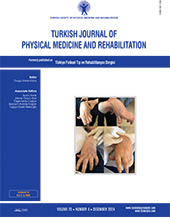Is home-based real-time video conferencing telerehabilitation as effective as conventional face-to-face rehabilitation in patients with operated for distal radius fracture? A single-blind, randomized prospective study
2 Department of Physical Medicine and Rehabilitation, Kırşehir Ahi Evran University Faculty of Medicine, Kırşehir, Türkiye
3 Department of Physical Therapy and Rehabilitation, Kırşehir Ahi Evran University, School of Physiotherapy and Rehabilitation, Kırşehir, Türkiye DOI : 10.5606/tftrd.2024.13739 Objectives: This study aims to investigate whether telerehabilitation is as effective as face-to-face rehabilitation in terms of joint range of motion (ROM), edema, and functionality in patients operated for distal radius fractures (DRFs).
Patients and methods: Between May 2022 and May 2023, a total of 54 patients (8 males, 46 females; mean age: 56.8±11.6 years; range, 24 to 77 years) who underwent volar plate due to DRF with direct X-ray and computed tomography (CT) were included in this single-blind, randomized study. The patients were randomly divided into the face-to-face group (FFG) and telerehabilitation group (TRG). The same rehabilitation program was applied as face-to-face and Home-Based Real-Time Video Conferencing (HBRVC) telerehabilitation. Demographic data and participation times in rehabilitation sessions were recorded. A perimeter was measured using the Figure of 8 method. The ROM of the joint was measured by goniometry. Hand grip strength was measured with a hand dynamometer, and pinch grip was measured with a pinch meter. The Patient-Rated Wrist Evaluation (PRWE) and Disabilities of the Arm, Shoulder and Hand Questionnaire (Quick-DASH) were used to assess functionality.
Results: In the initial evaluation, no statistically significant difference was found between age, smoking, dominant hand, operated hand, sex, and the number of participants in rehabilitation sessions (p>0.05). Comparing the values at Week 12 and Week 2, the change in pinch meter (p=0.007) and hand grip (p=0.030) values was higher in FFG than TRG. The Quick-DASH change (p<0.001) and PRWE change (p=0.001) values were statistically significantly lower in TRG than in FFG.
Conclusion: The HBRVC telerehabilitation program seems to be as effective as face-to-face rehabilitation on joint ROM and edema in patients undergoing volar plate fixation for DRF. However, the telerehabilitation method on functionality and muscle strength is less effective than face-to-face rehabilitation.
Keywords : Edema, range of motion, rehabilitation, telerehabilitation, wrist fractures

















